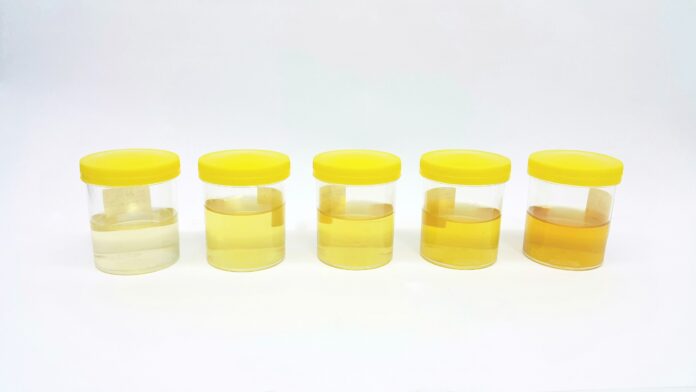Do you know what the color of your urine means? I always thought I was doing something right if my pee was clear, like water. However, that’s only sometimes accurate. Sometimes, clear urine can indicate overhydration, which isn’t good. Which made me wonder what does the color of urine mean?
Standard urine color ranges from pale yellow to deep amber. This results from a pigment called urochrome and how diluted or concentrated the urine is. Pigments and other compounds in certain foods and medications can change the color of your urine. For instance, beets, berries, and fava beans can influence a color change. Another example is OTC and prescription medications can give our urine a red, yellow, or greenish-blue tone.
An unusual urine color often indicates a sign of disease. A deep red or brown color is identifying characteristic of porphyria – a rare, inherited disorder of the blood cells.
What Does Each Color of Your Urine Mean?

Cloudy (Murky)
Cloudy urine can signify a urinary tract infection. It can also be a symptom of some chronic diseases and kidney conditions. In some cases, cloudy urine is another sign of dehydration. If you have cloudy urine and are pregnant, it could signify a dangerous condition called preeclampsia. You should contact your healthcare professional immediately and tell them if you develop cloudy or bubbly urine during pregnancy.
Clear
Clear urine indicates that you’re drinking more than the recommended water. While being hydrated is good, drinking too much water can rob your body of electrolytes. Urine that occasionally looks clear is no reason to panic, but urine that’s always clear could indicate that you need to cut back on how much water you’re drinking. Clear urine can also indicate liver problems like cirrhosis and viral hepatitis. You should see your doctor if you’re not consuming large amounts of water and have ongoing clear urine.
Yellowish to Amber
The color of “typical” urine falls on the spectrum of light yellow to a deeper amber color. The urochrome pigment naturally in your urine becomes more diluted as you drink water. Urochrome is produced by your body breaking down hemoglobin, the protein that carries oxygen in your red blood cells. In most situations, the color of your urine will depend on how diluted this pigment is. A lot of B vitamins in your bloodstream can also cause urine to appear neon yellow.
Red or Pink
This color isn’t necessarily severe despite its alarming appearance. Red or pink urine can be caused by:
- Blood – Factors that can cause urinary blood (hematuria) include urinary tract infections, an enlarged prostate, cancerous and noncancerous tumors, kidney cysts, long-distance running, and kidney or bladder stones.
- Foods – Beets, blackberries, and rhubarb can turn urine red or pink.
- Medications – Rifampin (Rifadin, Rimactane), an antibiotic often used to treat tuberculosis, can turn urine reddish orange — as can phenazopyridine (Pyridium), a drug that numbs urinary tract discomfort, and laxatives containing senna.
Orange
Orange urine can result from:
- Medications – Medications that can turn urine orange include the anti-inflammatory drug sulfasalazine (Azulfidine), phenazopyridine (Pyridium), some laxatives, and certain chemotherapy drugs.
- Medical conditions – In some cases, orange urine can indicate a problem with your liver or bile duct, especially if you also have light-colored stools. Dehydration, which can concentrate your urine and make it much deeper in color, can also make your urine appear orange.
Blue or Green
Blue or green urine can be caused by:
- Dyes – Some brightly colored food dyes can cause green urine. Dyes used for kidney and bladder function tests can turn urine blue.
- Medications – Several medications produce blue or green urine, including amitriptyline, indomethacin (Indocin, Tivorbex), and propofol (Diprivan).
- Medical conditions – Familial benign hypercalcemia, a rare inherited disorder, is sometimes called blue diaper syndrome because children with the disorder have blue urine. Green urine sometimes occurs during urinary tract infections caused by pseudomonas bacteria.
Dark Brown
Brown urine can result from:
- Food – Eating large amounts of fava beans, rhubarb or aloe can cause dark brown urine.
- Medications – Several drugs can darken urine, including the antimalarial drugs chloroquine and primaquine, metronidazole (Flagyl) and nitrofurantoin (Furadantin), laxatives containing cascara or senna, and methocarbamol — a muscle relaxant.
- Medical conditions – Some liver and kidney disorders and urinary tract infections can turn urine dark brown.
- Extreme exercise – Muscle injury from extreme exercise can result in pink or cola-colored urine and kidney damage.
Luckily, in most cases, abnormal urine color is simply a result of dehydration, food, or a side effect of medications you’re taking. Urine should resume its typical coloring within 2 to 3 days after you notice an unusual color.






